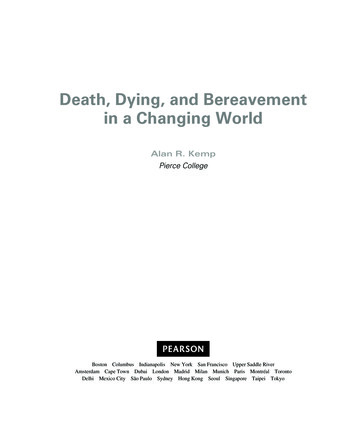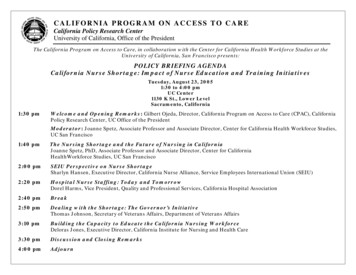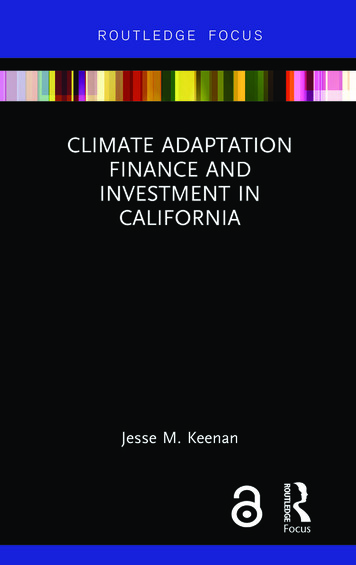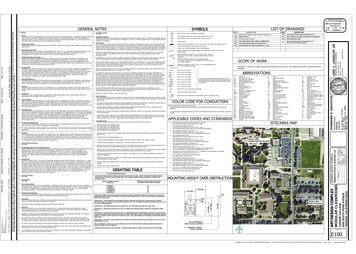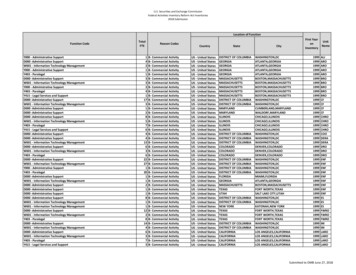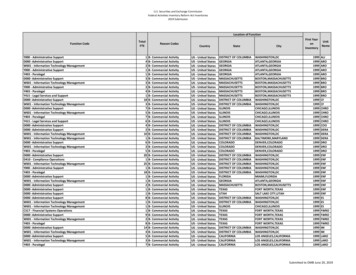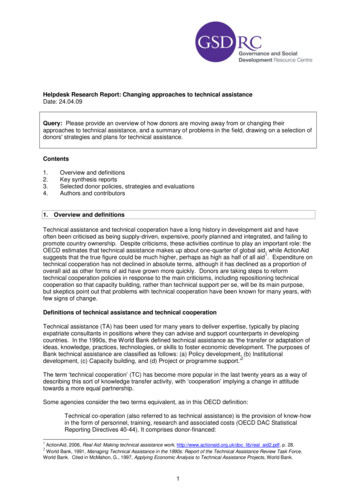
Transcription
S YM P O S I U M B R I E FINSURING CALIFORNIA IN AC H A N G I N G C L I M AT EAdapting the Industry to New Needs, Risks,and OpportunitiesMarch 2019BERKELEY LAW 1
Insuring California in a Changing ClimateClimate change poses risks to California’s economy, residents, infrastructure, cities, and naturalresources. The insurance industry, which provides financial protection to governments, individuals, andbusinesses for risks they face, will play a central role in efforts to the harmful impacts of climate changeon California. Yet the industry itself is vulnerable to a number of climate change-related risks that mayaffect its ability to maintain its historical level of protection throughout California. These risks involvethree main types: Physical risk: the increased likelihood of property damage, supply chain interruptions, health risksand other outcomes due to the physical impacts of climate change-related events; Transition risk: the impact to insurers’ assets of an economic transition away from carbon-intensiveindustries; and Liability risk: the potential for increased litigation against insureds and resulting liability due toclimate change-related losses.These risks will become significant individually and in the scale and dynamics of their interaction,posing a challenge to the insurance industry’s ability to protect Californians as the impacts of climatechange grow and solidify.In June 2018 the Center for Law, Energy & the Environment (CLEE) at UC Berkeley School of Lawconvened a group of insurance regulators, industry leaders, California energy and climate policymakers,climate data scientists, nonprofit researchers and advocates, and academics for a symposium focusingon the state of climate science and insurance modeling; climate litigation and other legal risks; assetvulnerability and disclosure; insurance product innovation and green investments; insurance availabilityand affordability; and integrating insurance policy with broader climate policy. They identified the toprisks and opportunities the insurance community and California residents face in a changing climate,as well as key regulatory reforms, new products, and technological and research developments neededto identify and address them.This symposium brief outlines the key insights these experts delivered, summarizing the key pointsfrom each section and panel of the event.BERKELEY LAW 1
Keynote Address - Dave Jones, California Insurance Commissioner (former)“Insurers are not adequately considering or addressing climate-related transition risk—the impactand risk of moving to an economy that does not rely on fossil fuels. More and more governments atthe local, state, and national levels are taking action to limit the use of fossil fuels. If consumers,businesses, markets, and governments take concerted action to dramatically reduce the use of fossilfuels, there is a risk that the value of fossil fuel investments will drop, and that they will become‘stranded assets’ on the books of insurance companies.It is the climate-related transition risk to insurerinvestments in coal, oil, gas, and utilities that resulted inmy launching in 2016 the Climate Risk Carbon Initiative.First, we asked all 1,300 insurance companies doingbusiness in California to voluntarily divest from theirinvestments in thermal coal enterprises and to refrainfrom future investments in them. Second, I requiredinsurers that write 100 million or more in premiumsnationally to disclose coal, oil, gas, and power-generatingutility investments. In 2018, we surveyed insurers againand updated and made public each insurer’s responseto my divestment request and more recent data ontheir coal, oil, and gas investments. More insurershave agreed to divest coal. We also engaged 2 DegreesInvesting Initiative and with their assistance the California Department of Insurance became thefirst United States-based regulator to conduct a climate risk scenario analysis of individual insurers’portfolios and a sector-wide analysis, consistent with the recommendations of the G-20 FinancialStability Board’s Task Force on Climate Related Financial Disclosures. In my last week as California’sInsurance Commissioner we completed another climate risk scenario analysis of insurers’ investmentportfolios, this time analyzing both physical and transition risk, making us the first financial regulatoranywhere in the world to conduct climate-related physical and transition risk scenario analysis ofinsurers’ investment portfolios. Insurers need to consider and address both climate-related physicaland transition risks, and insurance regulators have a critical role to play in making sure that insurersare considering and addressing all aspects of climate risk to their underwriting of insurance and theirinvestments of reserves.”These remarks have been edited and updated to reflect important developments in the second half of 2018.BERKELEY LAW 2
The State of Climate Science and Insurance Modeling: Identifying Risk, Certainty,and Insurance ImplicationsKey Points: Climate change is not a future but a “now” issue. California is already experiencing climate change, in the form of lostglacier mass and snowpack, warming ocean temperatures, increasing numbers of homes, businesses, and communitiesburned by wildfires, and changes in species ranges and timing of natural patterns. The State of California’s FourthClimate Change Assessment, which is intended to inform adaptation planning and implementation, should be afoundational document for all applicable policymaking. Climate change increases the severity, frequency, and unpredictability of catastrophic events, but insurers are developingsolutions to evaluate the risks. Real-time data collection via drones and other new technologies allows insurers to assessclaims and losses faster and at a greater level of detail. These abilities, in turn, allow insurers and governments to targetcritical geographies and infrastructure and better inform policymaking.Highlight Recommendation:Insurance regulators should encourage insurers to employ enhanced catastrophe (CAT) modeling in assessing risk andoffering policies. New capacities such as explicit ember and smoke simulations, accounting for the spread of fires into urbanareas, and measuring increasing precipitation volatility allow insurers to comprehensively assess new and evolving risks anddevelop innovative mitigation and suppression measures. Regulators can require insurers to demonstrate that they are usingthe most advanced methods to fine-tune the scope and pricing of coverage, as well as to calibrate their overall business models.Legal Liability: Climate Litigation and Other RisksKey Points: Climate change litigation is increasing as the actual costs of climate change begin to accumulate. The number of plaintiffsseeking remedies in court will grow as more businesses, governments, and individuals suffer climate-related personal andproperty losses. As a result, the defendants—those directly or indirectly responsible for emissions or for exacerbatingthe impacts—will likely look to insurance to limit their litigation and liability costs. The high number of venues in whichclimate suits are filed increases the likelihood that plaintiffs will eventually succeed. Climate change losses and impacts present a challenge for establishing and attributing legal liability. Slow-onset eventssuch as sea level rise and fast-onset events like wildfires can each confound traditional common-law theories such asnuisance and negligence and existing statutory schemes. But the increasing ability of science to attribute climate damagesmay prevail over long-standing legal procedure barriers and judicial reluctance to allow these disputes to come to trial. Lawsuits by local governments against major fossil fuel companies generate headlines, but smaller companies and licensedprofessionals may face greater risks. The largest companies are likely self-insured, but smaller players must buy insurancewith policies that may be implicated if a court establishes a path for liability against extractors or emitters. Corporatedirectors and licensed professionals, such as engineers and planners who hold heightened legal duties to protect or informclients and shareholders about potential climate risks, may be the first defendants to face liability.Highlight Recommendation:Insurers and insureds should increase disclosure of the physical, transition, and litigation risks they face due to climate change.While significant liability has not yet developed, failure to disclose material climate risks to investors and clients could emergeas an initial front of liability. Corporate entities should seek to set or meet the industry standard for disclosure, and insuranceregulators could consider strengthening requirements around disclosing threats to financial holdings.BERKELEY LAW 3
Asset Vulnerability: Assessing and Managing RisksKey Points: Modeling transition risks is subject to even greater uncertainty than modeling physical risks. CAT models are becomingincreasingly accurate and granular in predicting physical risks and disasters. But the same technical advances that supportCAT models and attribution science do not account for policy changes and market responses to the evolving risks ofclimate change. Asset managers and investors thus must account for an especially wide range of potential transitionscenarios, and they have an obligation to identify the worst-case scenarios. Governments and insurers are underinvesting in resiliency. Resiliency measures are generally known to repay in termsof both financial and human protection. Requiring disclosure may be insufficient to motivate action—policymakers mayneed to introduce more regulations requiring property inspections and the inclusion of 5-10 year risks in insurance pricing.Highlight Recommendation:Regulators could help investors and market leaders develop a set of agreed-upon and understood carbon supply curves inorder to plan for economic transition. These curves should be possible to produce based on existing corporate disclosure andthe known global emissions budget (i.e., the maximum quantity of emissions possible to avoid more than 2 degrees Celsius ofglobal warming) of approximately 900 gigatons of carbon and a range of policy and energy mix scenarios. Insurance regulatorscan increase efforts to require disclosure of fossil fuel holdings and compile industry-wide data on the transition threat.Insurance Innovation: New Products and Services, Proactive InvestmentsKey Points: Some insurers are innovating to support emissions reduction efforts. Insurers have undertaken 1500 climate-focusedactivities, including innovative insurance products, investment in clean energy, and public disclosure of climate risks.Solar shortfall insurance and energy efficiency insurance, which essentially guarantee minimum performance of newinvestments and installations that reduce emissions, are gaining traction. Advances in machine learning and real-timemeasurement will facilitate similar products for energy storage and electrical grid performance, all of which can helpgovernments reduce overall emissions. The insurance industry is beginning to return to a role of loss prevention in the context of climate change. Examplesinclude parametric insurance linking enhanced coastal resilience and ecosystem restoration. Pay-as-you-drive (PAYD) insurance offers a model to promote consumer-side greenhouse gas reduction, loss-prevention,and social equity simultaneously. By linking rates to miles driven, PAYD incentivizes reduced vehicle use—loweringemissions and the risk of covered losses. The PAYD pricing structure can also make vehicle insurance more affordablefor low-income consumers, thereby reducing costs for the low-income insured and reducing the number of uninsureddrivers. Policy makers could consider tax incentives or mandates to drive insurer offerings and further innovation basedon this model.Highlight Recommendation:Property insurers can lead the way on innovative green insurance products. Measures such as rate discounts for green buildings(which present less overall risk of loss) and coverage upgrades for insureds who improve structures after a covered loss canserve the interests of insurers and insureds alike. Regulators could consider methods to improve customer awareness andreduce barriers to the introduction of these products.BERKELEY LAW 4
Insurance Availability and Affordability in a Changing ClimateKey Points: High fire-risk areas in California are experiencing higher increases in insurance premiums, greater rates of policy nonrenewal, refusal to write new coverage, and lower coverage-to-value ratios. To best serve high-risk areas, insurers need to beable to use probabilistic fire models that evaluate risk at the individual property level and vary rates based on differencesin their risk levels. Insurers also need to communicate what standards are required to be eligible for coverage and for thevarious rate tiers. Community-level action may be necessary to maintain insurance availability and affordability in high-risk areas. Becauseinsurers assess risk at both the individual home and community level, homeowners need to work with local governmentsto adopt protective planning, construction, and vegetation measures at the community level that are consistent with insurerunderwriting considerations in order to continue to find coverage. Community-based pooled insurance policies could offer a way forward as more areas are classified as high-risk for fireand flood. As risks become more persistent and pervasive, insuring at the community level may be the most efficient andpredictable way to protect individuals within vulnerable areas. This innovative model—involving a single policy betweena community and an insurer that would provide insurance to designated properties, with streamlined claims processes—could bring detailed risk information, insurance expertise, and community planning together.Highlight Recommendation:State legislators can propose industry reforms that help ensure affordability and availability in all communities. Measureslike mandatory renewal offers for residents whose properties meet mitigation and defensible-space requirements, coveragefor replacement costs when policyholders choose to rebuild in new locations, and extended time periods to recover buildingreplacement costs and living expenses would all help better protect residents affected by climate disasters.Toward Better Coordination between the Insurance and Climate Research and PolicyCommunities - Ken Alex, Senior Advisor to Governor Brown and Director of theGovernor’s Office of Planning and Research (former)Highlight Recommendations:Policymakers and industry leaders should: Encourage land use planning that addresses the intersection of climate mitigation and resiliency and insurance innovation.Transportation accounts for nearly 50% of California’s greenhouse gas emissions, and land use decisions directly affecttransportation levels. Land use planning also determines how many homes are located in areas most vulnerable to wildfire,flood, and sea-level rise. Insurers and regulators can collaborate to incentivize resilient planning and behavior-inducinginnovative insurance products. Ensure accurate estimations of corporate physical risk. Major facilities are key drivers of the California economy and areoften located in areas vulnerable to flood and sea level rise. Insurers and policymakers need to assess these risks properly forthe health of the statewide economy. Assess and address risk on a community and statewide scale. California insurance and climate regulators can coordinateto ensure that local governments, residents, and insurers are taking appropriate action to limit exposure to climate changerisks, reduce overall harm to businesses and individuals, and provide affordable coverage for when losses inevitably occur.BERKELEY LAW 5
Agenda and ParticipantsKeynote AddressDave Jones, California Insurance Commissioner (former)The State of Climate Science and InsuranceModeling: Idenitfying Risk, Certainty and InsuranceImplicationsLouise Bedsworth, Governor’s Office of Planning andResearchRobert Muir-Wood, RMSJose Peralta, AonBruce Riordan, Climate Readiness InstituteLegal Liability: Climate Litigation and Other RisksCara Horowitz, UCLA School of LawTed Lamm, CLEELindene Patton, Earth & Water Law GroupJessica Wentz, Sabin Center for Climate Change LawAsset Vulnerability: Assessing and Managing RisksAaron Ezroj, California Department of InsuranceAlice Hill, Hoover InstitutionTricia Jamison, 2 Investing InitiativeHenrik Jeppesen, Carbon Tracker InitiativeNik Steinberg, Four Twenty SevenInsurance Innovation: New Products andServices, Proactive InvestmentsStephen Bushnell, Stephen Bushnell AssociatesRichard Jones, The Hartford Steam BoilerInspection and Insurance CompanyEvan Mills, Lawrence Berkeley National LaboratoryClaudia Polsky, UC Berkeley School of LawInsurance Availability and Affordability in aChanging ClimateLloyd Dixon, RAND CorporationEthan Elkind, CLEEJoel Laucher, California Department of InsuranceKathleen Schaefer, UC DavisToward Better Coordination Between theInsurance and Climate Research and PolicyCommunitiesKen Alex, Senior Advisor to Governor Brown andDirector of the Governor’s Office of Planning andResearch (former)Photo courtesy of Flickr's Daniel RamirezBERKELEY LAW 6
Center for Law, Energy & the Environment (CLEE)UC Berkeley School of Law390 Simon HallBerkeley, CA 94720-7200www.clee.berkeley.eduFor further information, including background research and presentations, ents/insuring-california/Contacts:Ethan Elkind, Director of the Climate Program at CLEE, at eelkind@law.berkeley.eduTed Lamm, Research Fellow in the Climate Program at CLEE, at tlamm@law.berkeley.edu.
In June 2018 the Center for Law, Energy & the Environment (CLEE) at UC Berkeley School of Law convened a group of insurance regulators, industry leaders, California energy and climate policymakers, climate data scientists, nonprofit researchers and advocates, and academics for a symposium focusing

